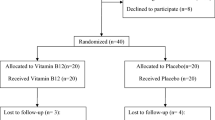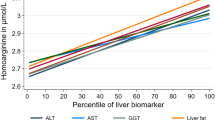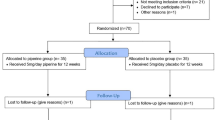Abstract
Objective:
To examine the effect of purple sweet potato (PSP) beverage rich in acylated anthocyanins on serum hepatic biomarkers in healthy Japanese men.
Design:
A randomized, double-blind, placebo-controlled, parallel study.
Setting:
Kumamoto in Japan.
Subjects:
Healthy adult men (30–60 years) with borderline hepatitis who had one or more of serum γ-glutamyl transferase (GGT), aspertate aminotransferase (AST) and alanine aminotransferase (ALT) levels over normal ranges, and who were negative for hepatitis virus were openly recruited by an advertisement. Of the 48 persons enrolled, 38 (mean age 43.0 years (30–54 years)) completed the study.
Methods:
The subjects were randomly assigned to the PSP group and the placebo group. During the 8-week intervention, the subjects in the PSP group consumed two bottles of the PSP beverage with acylated anthocyanins (200.3 mg anthocyanins per 125 ml per bottle) per day, and the subjects in the placebo group, two bottles of a placebo beverage (1.7 mg anthocyanins per 125 ml per bottle). All of the data measured were analyzed by two-way repeated measures analysis of variance (ANOVA) with groups and times. The data of the hepatic markers were analyzed using the Dunnett multiple comparison among the time points and t-test between groups at the same time point. Two-sided P<0.05 were defined as the level of significance.
Results:
Serum GGT, AST and ALT levels showed interactions (P<0.05) between the beverage groups and time; the others were not affected. The PSP beverage group showed lower hepatic marker levels than the placebo group during the ingestion period, particularly the GGT level (−14.1 IU/l, 95% Confidence intervel (CI) −25.4 to −2.7, P=0.017 at 2 weeks; −16.8 IU/l, 95% CI −36.2 to 2.5, P=0.081 at 4 weeks; −26.7 IU/l, 95% CI −47.6 to −5.7, P=0.014 at 6 weeks and −27.9 IU/l, 95% CI −49.9 to −5.9; P=0.014 at 8 weeks). No correlation between alcohol consumption and each hepatic biomarker level before and after the ingestion was observed.
Conclusion:
The intake of the PSP beverage significantly decreased the serum levels of hepatic biomarkers, particularly the GGT level, in healthy men with borderline hepatitis.
This is a preview of subscription content, access via your institution
Access options
Subscribe to this journal
Receive 12 print issues and online access
$259.00 per year
only $21.58 per issue
Buy this article
- Purchase on Springer Link
- Instant access to full article PDF
Prices may be subject to local taxes which are calculated during checkout





Similar content being viewed by others
References
Cederbaum AI (2002). Introduction-serial review: alcohol, oxidative stress and cell injury. Free Radic Biol Med 31, 1524–1526.
Chick J, Kreitman N, Plant M (1981). Mean cell volume and gamma-glutamyl-transpeptidase as markers of drinking in working men. Lancet 1, 1249–1251.
Edwards MJ, Keller BJ, Thurman RG (1993). The involvement of Kupffer cells in carbon tetrachloride toxicity. Toxicol Appl Pharmacol 119, 275–279.
Falck-Ytter Y, Younossi ZM, Marchesini G, McCullough AJ (2001). Clinical features and natural history of nonalcoholic steatosis syndromes. Semin Liver Dis 21, 17–26.
Harada K, Kano M, Takayanagi T, Yamakawa O, Ishikawa F (2004). Absorption of acylated anthocyanins in rats and humans after ingesting an extract of Ipomoea batatas purple sweet potato tuber. Biosci Biotechnol Biochem 68, 1500–1507.
Hertog MGL, Feskens EJM, Hollman PCH, Katan MB, Kromhout D (1993). Dietary antioxidant flavonoids and risk of coronary heart disease: The Zutphen elderly study. Lancet 342, 1007–1011.
Kano M, Takayanagi T, Harada K, Makino K, Ishikawa F (2005). Antioxidative activity of anthocyanins from purple sweet potato, Ipomoea batatas cultivar Ayamurasaki. Biosci Biotechnol Biochem 69, 979–988.
Karp DR, Shimooku K, Lipsky PE (2001). Expression of γ glutamyltranspeptidase protects ramos B cells from oxidation-induced cell death. J Boil Chem 276, 3798–3804.
Keli SO, Hertog MGL, Feskens EJM, Kromhout D (1996). Dietary flavonoids, antioxidant vitamins, and incidence of stroke: The Zutphen study. Arch Intern Med 156, 637–642.
Kugelman A, Choy HA, Liu R, Shi MM, Gozal E, Forman HJ (1994). γ-Glutamyl transpeptidase is increased by oxidative stress in rat alveolar L2 epithelial cells. Am J Respir Cell Mol Biol 11, 586–592.
Lee DH, Jacobs Jr DR, Gross M, Kiefe CI, Roseman J, Lewis CE et al. (2003). γ-Glutamyltransferse is a predictor of incident diabetes and Hypertension: the Coronary Artery Risk Development in Young Adults (CARDIA) Study. Clin Chem 49, 1358–1366.
Lee DH, Steffen LM, Jacob Jr DR (2004). Association between serum γ-glutamyltransferase and dietary factors: the Coronary Artery Risk Development in Young Adults (CARDIA) Study. Am J Clin Nutr 79, 600–605.
Nakanishi N, Nishina K, Li W, Sato M, Suzuki K, Tatara K (2003). Serum γ-glutamyltransferase and development of impaired fasting glucose or type 2 diabetes in middle aged Japanese men. J Intern Med 254, 287–295.
Negri E, La Vencchia CL, Franceschi S, D'Avanzo B, Parazzini F (1991). Vegetable and fruit consumption and cancer risk. Int J Cancer 48, 350–354.
Perry IJ, Wannamethee SG, Shaper AG (1998). Prospective study of serum γ-glutamyltransferase and risk of NIDDM. Diabetes Care 21, 732–737.
Recknagel RO, Glende EA (1973). Carbon tetrachloride hepatotoxicity: an example of lethal damage. CRC Crit Rev Toxicol 2, 263–297.
Shaper AG, Pocock SJ, Ashby D, Walker M, Whitehead TP (1985). Biochemical and haematological response to alcohol intake. Ann Clin Biochem 22, 50–61.
Skinner HA, Holt S, Schuller R, Roy J, Israel Y (1984). Identification of alcohol abuse using laboratory tests and a history of trauma. Ann Intern Med 101, 847–851.
Suda I, Furuta S, Nishiba Y, Yamakawa O, Matsugano K, Sugita K (1997). Reduction of liver injury induced by carbon tetrachloride in rats administered PSP juice. J JPN Soc Food Sci Technol (in Japanese) 44, 315–318.
Suda I, Oki T, Matsuda M, Nishida Y, Furuta S, Matsugano K et al. (2002). Direct absorption of acylated anthocyanin in purple-fleshed sweet potato into rats. J Agric Food Chem 50, 1672–1676.
Suda I, Yamakawa O, Matsugano K, Sugita K Takeguma Y, Irisa K, Tokumaru F (1998). Change of serum g-GPT, GOT and GPT levels in hepatic function-weakling subjects by ingestion of high anthocyanin sweet potato juice. J JPN Soc Food Sci Technol (in Japanese) 45, 611–617.
Takahashi Y, Oakes SM, Williams MC, Takahashi S, Miura T, Joyce-Brady N (1997). Nitrogen dioxide exposure activates γ-glutamyltransferase gene expression in rat lung. Toxicol Appl Pharmacol 143, 388–396.
Whitehead TP, Clarke CA, Whitfield AGW (1978). Biochemical and haematological markers of alcohol intake. Lancet 1, 978–981.
Yamada Y, Noborisaka Y, Suzuki H, Ishizaki M, Yamada S (2003). Alcohol consumption, serum γ-glutamyltransferase levels, and coronary risk factors in a middle-aged occupational population. J Occup Health 45, 293–299.
Yamakawa O et al. (1998). Development and utilization of sweet potato cultivars with high anthocyanin content. Foods Food Ingredients J JN 178, 69–78.
Acknowledgements
We are grateful to M Watanuki and C Kai of Yakult Honsha for their discussions and advices throughout this study. We also thank Y Suzuki and O Watanabe of the Faculty of Research and Development of Yakult Honsha, for manufacturing the beverage samples and for the adjustment of this study, respectively.
Author information
Authors and Affiliations
Corresponding author
Rights and permissions
About this article
Cite this article
Suda, I., Ishikawa, F., Hatakeyama, M. et al. Intake of purple sweet potato beverage affects on serum hepatic biomarker levels of healthy adult men with borderline hepatitis. Eur J Clin Nutr 62, 60–67 (2008). https://doi.org/10.1038/sj.ejcn.1602674
Received:
Revised:
Accepted:
Published:
Issue Date:
DOI: https://doi.org/10.1038/sj.ejcn.1602674
Keywords
This article is cited by
-
The effect of total anthocyanin-base standardized (Cornus mas L.) fruit extract on liver function, tumor necrosis factor α, malondealdehyde, and adiponectin in patients with non-alcoholic fatty liver: a study protocol for a double-blind randomized clinical trial
Nutrition Journal (2019)
-
Flavonoid intake from fruit and vegetables during adolescence is prospectively associated with a favourable risk factor profile for type 2 diabetes in early adulthood
European Journal of Nutrition (2019)
-
Double-blind, placebo-controlled pilot trial of anthocyanin-rich purple sweet potato beverage on serum hepatic biomarker levels in healthy Caucasians with borderline hepatitis
European Journal of Clinical Nutrition (2017)



